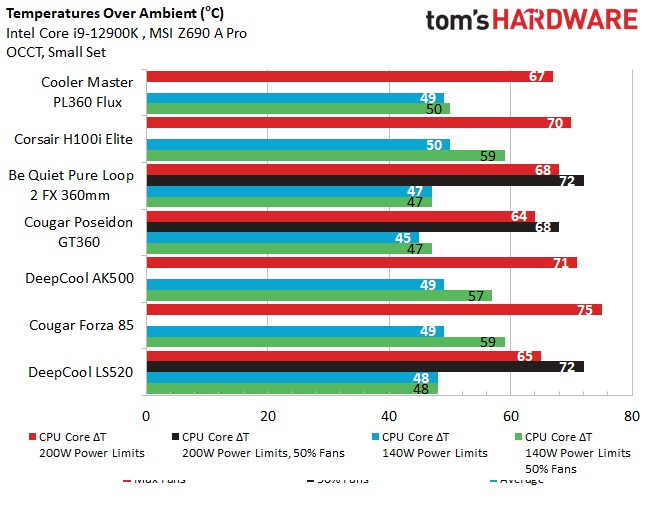Why you can trust Tom's Hardware
Cinebench Test Results
Running Cinebench without power limits is the most thermally demanding load in my testing, and most coolers don't pass this specific test. While the PL 360 Flux does well in other metrics, it wasn’t able to handle the heat of this test without throttling. This isn’t necessarily a bad thing, it’s just a sign of how hard the i9-12900K can be to properly cool in some scenarios.
Other CPUs, such as AMD’s Ryzen 5900x or Intel’s i5-12600k won’t be nearly as difficult to cool in these scenarios.
When power limits are restricted to a more reasonable 200W, the PL360 Flux runs a few degrees warmer than the competition, at 66 degrees celsius over ambient. While not beating it’s competition in this scenario, it does run quieter than any of the other coolers I’ve tested so far. We’ll cover acoustic measurements in the next section. That said, the PL360 isn’t able to run without throttling when the fan speeds are reduced to 50%.
OCCT Test Results
I like to run OCCT's small set stress testing for stability when overclocking. But on Alder Lake, I haven't found a cooler that's capable of handling OCCT without throttling unless power limits are enforced.
I test OCCT at 200W to demonstrate a thermally demanding load, but also with a 140W power limit enforced to show how these coolers might perform with a CPU that's easier to cool, like Intel's i5-12400 or AMD's Ryzen 5600X.
The performance of the PL360 Flux in OCCT was similar to Cinebench. With a 200W power limit, the PL360 ran slightly warmer than the competition. When limited to 140W, the PL360 Flux was just barely warmer than the competition (by a degree or two), but ran quieter. See the next section covering Acoustics for more information.
Noise Levels and Acoustics
To test noise levels, I used the SLM25TK Sound Level Meter, positioned 18 inches behind the rear of the Be Quiet Silent Base 802 PC case, and recorded early in the morning to achieve the lowest noise floor possible. The chart below shows averaged results, recorded over the course of five minutes, to account for sudden variations in measurements.
Get Tom's Hardware's best news and in-depth reviews, straight to your inbox.
Even with hotter workloads, Cooler Master’s PL360 Flux will run rather quietly. When limited to 50% fan speeds, it is the quietest cooler of the 4 units tested for this review - beating Be Quiet at it’s name by a significant margin. When run at maximum fan speeds, the PL360 runs roughly equal in volume to Be Quiet’s Pure Loop 2 FX.
Conclusion
I wondered if Cooler Master’s PL360 Flux would be capable of cooling Alder Lake well, given the increased difficulty of cooling in certain scenarios, and the fact that it was launched previous to Alder Lake’s arrival. While this cooler wasn’t quite able to handle the 12900K when power limits are removed, the PL360 Flux was able to adequately cool 200W which makes it a good Tier 2 Cooler capable of handling the vast majority of workloads. Lovers of silence will be pleased to know that this is the quietest cooler I’ve tested thus far, and it’s thin radiator make Cooler Master’s PL360 Flux ideal for small cases–so long as there is mounting space for three 120mm fans.
MORE: Best AIO Coolers
MORE: How to Buy the Right CPU Cooler

Albert Thomas is a contributor for Tom’s Hardware, primarily covering CPU cooling reviews.
-
thedexmonster Will there be a review of the 30th Edition Flux? Based on the spec sheet it should be significantly better, but the $200 price tag is hard to swallow without testing. I would like to see it against the new EK Nucleus since it tops the charts!Reply


